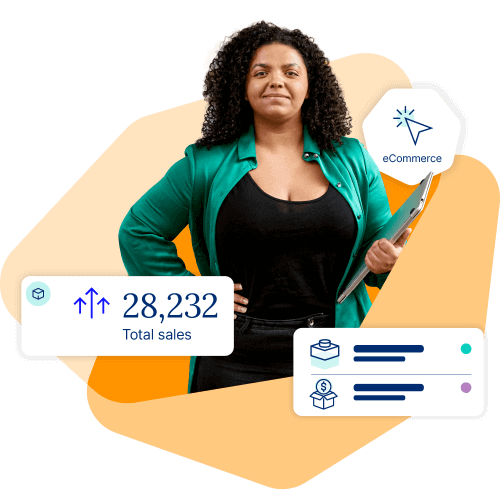
New technologies continue to drive innovation in the ecommerce world. How is your site keeping up? Check out our predictions for the top 10 technologies that will drive ecommerce growth in 2022.
Increasingly, consumers are using their voice and images to search online. As a result, businesses that want search bots to find them should incorporate text that mimics spoken questions into their sites along with high quality images.
AI chatbots may be the future for the ecommerce industry. Their sophisticated programming allows the AI chatbot to respond to customers as if the chatbot were a real human being.
Unlike rule-based chatbots, AI chatbots are constantly learning from their conversations and can develop unscripted responses to queries. They are designed to read tone and emotion as well as help customers get the best recommendations for the products and services they are seeking.
Brick-and-mortar retailers do not like seeing customers looking at their phone screens, for it indicates that the customer is price shopping or using their store as a showroom for a later online purchase elsewhere.
Therefore, savvy retailers offer their own GPS-enabled mobile shopping experiences to help customers buy in-store or anywhere else. For any retailer, a mobile-optimized site and store is a fundamental element of a positive ecommerce experience.
The term omnichannel refers to the integration of multiple channels for ecommerce, such as an online storefront, website, or social media page. When you offer omnichannel support, your customers can enter information in one channel, and you can access it in another, providing a more seamless customer experience across channels.
Speedy and secure e-wallet technology allows customers to store all of their payment information digitally in one place. This increases efficiency when shopping online because instead of having to enter information for each purchase, customers can check out of a site with just one or two clicks of a button.
Businesses equipped to accept e-wallet payments can level themselves up in the ecommerce market with better scalability of services and reciprocal security to attract even more customers.
The concept of the Metaverse is still evolving, and it isn’t ready as an advertising platform. However, it represents a potent potential marketing channel for various ecommerce brands. Global brands like Nike, Coca-Cola, Vans, and Gucci are already gearing up to treat their customers with virtual products.
Various gaming systems have also opened their platforms to ecommerce brands. For instance, leading fashion brand Balenciaga recently teamed up with Epic Games to launch its Fortnight clothing line. Nike turned to Roblox to launch Nikeland for purchasing virtual Nike gear for the gaming avatars.
Remember TV shopping channels? Livestream commerce or Livestream shopping is almost like that. It is a video streamed on a commercial platform where the host shows viewers various goods in real-time. Thus, the audience can easily buy products directly from the shopping site.
This type of ecommerce is very popular in China. For instance, in 2020, during the Global Shopping Festival on the Taobao platform, live broadcast generated sales of about $6 billion. Companies in the US have also noticed a tendency toward this upgraded version of ‘shoptainment.’
This approach to online retail lets you present items in every dynamic and develop client interest by creating urgency with limited-quantity or limited-time offers.
Headless commerce is a solution that lets an online store’s ecommerce platform de-couple from the front-end presentation layer. More ecommerce businesses have adopted headless technology due to its flexibility on the backend, added SEO and digital experience capabilities, and content marketing.
The progressive web app is a technology that lets you create web applications that look like native mobile apps. While building these solutions, developers use web technologies like JavaScript, CSS, and HTML.
Retail giants like Walmart and Alibaba have used PWA to generate more revenue and increase conversion rates. Progressive web apps are perfectly suitable for any small and medium-sized organization.
PWA’s primary functions include:
Popular brands know that the bigger your business, the more crucial it is to have a scalable infrastructure. Cin7’s flexible, future-proofed and hyper-scalable inventory management software is purposely built for retail businesses.
It offers various integrations with a speedy, expert-led implementation having a success rate of 97%.
More innovations in ecommerce technology are likely to evolve in 2022. As you evaluate whether a new technology is worth incorporating in your business, consider magnitude, relevancy, and functionality. While some may provide a huge value, others might be out of touch with your particular customer demographic or be too costly. One technology we certainly recommend is Cin7 inventory management software.
Cin7 inventory management software makes all your business operations, like purchasing, selling, warehousing, accounting, and shipping, hassle-free and virtually effortless in order for you and your management team to focus more on other aspects of your business.


The Greek philosopher, Heraclitus, once stated, “The only constant in life is change.” While this observation is applicable to how we can live our best lives, it also relates to the business world. If businesses did not actively upgrade their products, we would still be using products that are nowhere close to meeting their potential […]

Online shopping has become an integral part of the post-pandemic era. If you had a business with one or more stores, you probably had to shut your doors during the lockdown. While most brick-and-mortar stores had to close, online stores continued to flourish. Experienced companies got creative and started selling online, on social media, and […]

Gift guides are a great way to make your ecommerce store more appealing to customers. They can be used for any niche, but they are particularly effective in the food and beverage sector. Essentially, a gift guide is a list of products that are offered at a discounted price. They can be used as an […]